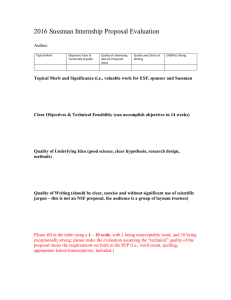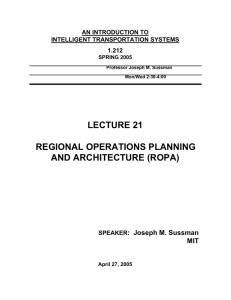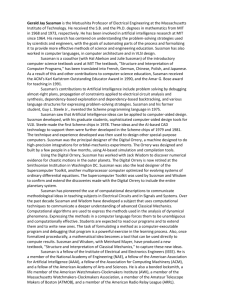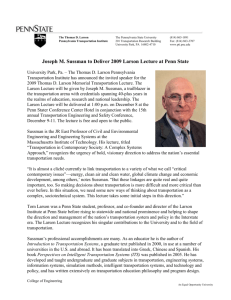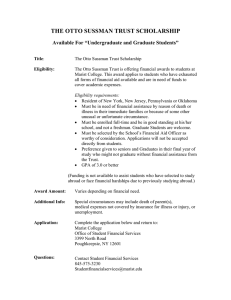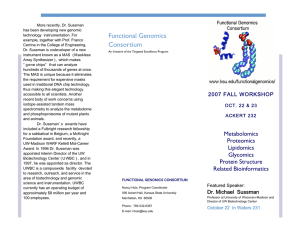PPT
advertisement
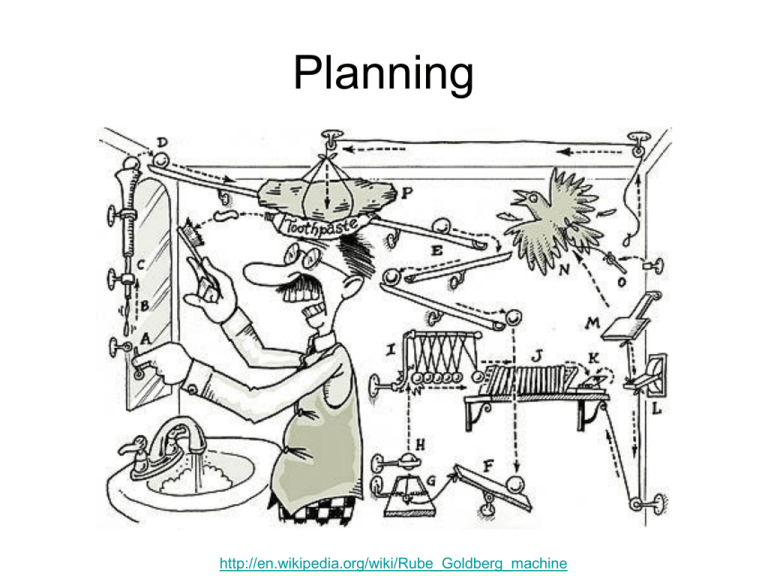
Planning http://en.wikipedia.org/wiki/Rube_Goldberg_machine Planning • How is planning different from regular search? – States and action sequences typically have complex internal structure – State space and branching factor are huge – Multiple objectives, resource constraints • Examples of planning applications – – – – – Scheduling of tasks in space missions Logistics planning for the army Assembly lines, industrial processes Robotics Games, storytelling A representation for planning • STRIPS (Stanford Research Institute Problem Solver): classical planning software and formal language from the 1970s • States are specified as conjunctions of predicates – Start state: At(P1, CMI) Plane(P1) Airport(CMI) Airport(ORD) – Goal state: At(P1, ORD) • Actions are described in terms of preconditions and effects: – Fly(p, source, dest) • Precond: At(p, source) Plane(p) Airport(source) Airport(dest) • Effect: ¬At(p, source) At(p, dest) • Planning is “just” a search problem Challenges of planning: “Sussman anomaly” Start state: Goal state: On(A,B) On(B,C) Let’s try to achieve On(A,B): Let’s try to achieve On(B,C): http://en.wikipedia.org/wiki/Sussman_Anomaly Challenges of planning: “Sussman anomaly” • Shows the limitations of non-interleaved planners that consider subgoals in sequence and try to satisfy them one at a time – If you try to satisfy subgoal X and then subgoal Y, X might undo some preconditions for Y, or Y might undo some effects of X • More powerful planning approaches must interleave the steps towards achieving multiple subgoals http://en.wikipedia.org/wiki/Sussman_Anomaly Complexity of planning • Planning is PSPACE-complete – The length of a plan can be exponential in the number of “objects” in the problem! – Example: tower of Hanoi Algorithms for planning • Forward (progression) state-space search: starting with the start state, find all applicable actions (actions for which preconditions are satisfied), compute the successor state based on the effects, keep searching until goals are met – Can work well with good heuristics • Backward (regression) relevant-states search: start at the goal and apply actions backward until you find a sequence of steps that reaches the initial state • Reduce planning to a SAT problem or CSP • Partial order planning Partial order planning • Task: put on socks and shoes Total order (linear) plans Partial order plan Partial order planning • Task: change flat tire Start: empty plan Action: find flaw in the plan and modify plan to fix the flaw Situation space planning vs. plan space planning • Situation space planners: each node in the search space represents a world state, arcs are actions in the world – Plans are sequences of actions from start to finish – Must be totally ordered • Plan space planners: nodes are (incomplete) plans, arcs are transformations between plans – Actions in the plan may be partially ordered – Principle of least commitment: avoid ordering plan steps unless absolutely necessary Application of planning: Automated storytelling https://research.cc.gatech.edu/inc/mark-riedl Application of planning: Automated storytelling • Applications – Personalized experience in games – Automatically generating training scenarios (e.g., for the army) – Therapy for kids with autism – Computational study of creativity https://research.cc.gatech.edu/inc/mark-riedl Real-world planning • Resource constraints • Actions at different levels of granularity: hierarchical planning • Incorporating sensing and feedback • Contingencies: actions failing • Uncertainty
